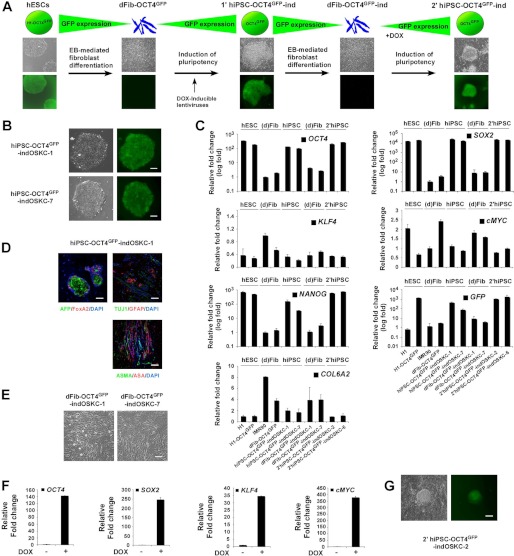FIGURE 1.
Generation of the dFib-OCT4GFP–ind-OSKC reporter system. A, schematic representation of the methodology used to obtain dFib-OCT4GFP–ind fibroblast-like cells expressing the four reprogramming factors. EB, embryoid body; DOX, doxycycline. B, primary hiPSC colonies obtained from dFib-OCT4GFP after infection with inducible lentiviruses expressing the four reprogramming factors. Note that hiPSC colonies have regained the expression of GFP. Scale bar = 100 μm. C, real-time PCR analysis was performed for the pluripotent markers OCT4, SOX2, NANOG, the reprogramming factors KLF4 and cMYC, the fibroblast marker COL6A2, and for GFP. Data are shown as relative means ± S.D. of two biological replicates analyzed in triplicate. D, teratoma formation was assessed by injection of the hiPS-OCT4GFP–ind-OSKC-1 cell line into the testes or kidney of SCID mice. Immunofluorescence analysis demonstrates the existence of the three main embryonic germ layers as defined by the expression of specific endodermal (α-fetoprotein (AFP) and FoxA2), ectodermal (TUJ1 and glial fibrillary acidic protein (GFAP), and mesodermal (α-smooth muscle actin (ASMA) and α sarcomeric actin (ASA)) markers. All images were obtained from the same tumor. DAPI was used to visualize the nuclei. Scale bar = 200 μm. E, morphology of the dFib-OCT4GFP–ind-OSKC fibroblasts cell lines after embryoid body-mediated differentiation. Scale bar = 50 μm. F, dFib-OCT4GFP–indOSKC-7 cells were treated with 100 ng/ml doxycycline for 48 h. Real-time PCR analysis was performed for OCT4, SOX2, KLF4, and cMYC. Data are shown as relative means ± S.D. of two biological replicates analyzed in triplicate. G, Secondary hiPSC colonies isolated from dFib-OCT4GFP-ind-OSKC cells after doxycycline treatment. Note that hiPSC colonies are GFP-positive. Scale bar = 100 μm.

